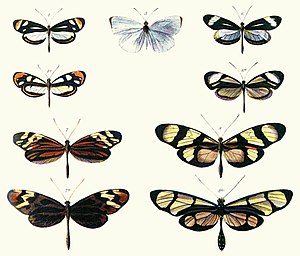ସାଦୃଶ୍ୟ

ବିବର୍ତ୍ତନ ପ୍ରାଣୀ ବିଜ୍ଞାନ evolutionary biology ଅନୁସାରେ ସାଦୃଶ୍ୟ (ଇଂରାଜୀ ଭାଷାରେ mimicry) ଏକ ବିବର୍ତ୍ତନ ସାଦୃଶ୍ୟ ଯାହା ଗୋଟିଏ ଜୀବ ସହ ଅନ୍ୟ ଗୋଟିଏ ପଦାର୍ଥ ବା ଅନ୍ୟ ଜୀବ ସହିତ ସାଦୃଶ୍ୟ ଥାଏ । ଅନେକ ସମୟରେ ଏହି ସାଦୃଶ୍ୟ ଜୀବକୁ ତାହାର ଖାଦକମାନଙ୍କଠାରୁ ସୁରକ୍ଷା ମିଳିବାକୁ ଉପଯୋଗୀ ହୋଇଥାଏ । [୧] ସମଦୃଷ୍ଟି ହେବା ଯୋଗୁ ହିଂସ୍ର ଜନ୍ତୁମାନଙ୍କର ବ୍ୟବହାର ବଦଳିଯାଏ ଯାହା ଶିକାରକୁ ସୁରକ୍ଷା ପ୍ରଦାନ କରିଥାଏ । [୨] ଏହି ସାଦୃଶ୍ୟ ବିଭିନ୍ନ ପ୍ରକାର ହୋଇପାରେ ଯେପରିକି ଦୃଷ୍ଟ, ଶ୍ରବଣ, ରାସାୟନିକ, ସ୍ପର୍ଶ ବା ବୈଦୁତିକ ଓ ଏମାନଙ୍କର ଗ୍ରହଣଶୀଳ ମିଶ୍ରଣ ହୋଇପାରେ । [୨][୩] ଏହ ଉଭୟ ଖାଦ୍ୟ ଓ ଖାଦକକୁ ଲାଭପ୍ରଦ ହୋଇପାରେ । ପକ୍ଷୀମାନେ ଦେଖିକରି ସ୍ୱାଦିଷ୍ଟ ପୋକଙ୍କୁ ଚିହ୍ନିପାରନ୍ତି ଓ ହାନୀକାରକ ଦ୍ରବ୍ୟ ବା ପ୍ରାଣୀଙ୍କଠାରୁ ଦୂରେଇ ଯାଆନ୍ତି । ବେଳେ ବେଳେ ଉଭୟ ପକ୍ଷଙ୍କର ସାଦୃଶ୍ୟ ଥିବା ଦେଖାଯାଏ ।[୪] ଅନେକ ପ୍ରଜାତିର ପ୍ରାଣୀମାନଙ୍କର ସାଦୃଶ୍ୟ ଥାଏ ଯେପରକି ବିରୁଡ଼ିଙ୍କଠାରୁ ହୋଭରଫ୍ଲାଇ ରକ୍ଷା ପାଇପାରନ୍ତି । ଶିକାର ଓ ଶିକାରୀ ମଧ୍ୟରେ ହେଉଥିବା ସାଦୃଶ୍ୟ ପ୍ରାୟ ୩ ବା ଅଧିକ ପ୍ରଜାତିଙ୍କଠାରେ ଦେଖାଯାଏ । [୫]
ବ୍ୟାପକ ଅର୍ଥରେ ସାଦୃଶ୍ୟରେ ନିର୍ଜୀବମାନଙ୍କୁ ମଧ୍ୟ ନିଆଯାଇପାରେ । ନିର୍ଜୀବଙ୍କ ପାଇଁ ବେଳେ ବେଳେ ମାସ୍କେରେଡ ଓ ମାଇମେସିସ ଶବ୍ଦ ବ୍ୟବହାର କରାଯାଏ । [୬][୩][୭] ଉଦାହରଣ ସୁରୂପ ପ୍ଲାଣ୍ଟହପର (planthoppers), ପୋଲିଗୋନିଆ ସି-ଆଲବନ (comma) ଓ ଜେଓମିଟର ମଥ (geometer moth) ସଂବାଳୁଆ ଆଦି ପ୍ରାଣୀମାନଙ୍କର ଗଛର ଛାଲି, ପତ୍ର ଓ ଫୁଲ ସହିତ ସାମଞ୍ଜସ୍ୟ ଥାଏ । [୩][୪][୮][୯] କେତେକ ପ୍ରାଣୀଙ୍କର ଆଖି ବଡ଼ ପଶୁଙ୍କ ଆଖି ଭଳି ଦେଖାଯାଏ । ଏହି ଆଖି ଦେଖି ଅନ୍ୟ ପଶୁମାନେ ପ୍ରତିକ୍ରିୟା ସୃଷ୍ଟି କରନ୍ତି କି ନାହିଁ, ତାହା ଜଣାଯାଇ ନାହିଁ । [୧୦] ଏହାକୁ ଆଧୁନିକ ସାହିତ୍ୟରେ ଦେଖାଯାଉଛି । [୧୧][୧୨][୧୩]

ସାଦୃଶ୍ୟ ଯୋଗୁ ବିବର୍ତ୍ତନାତ୍କକ ଦୌଡ଼ରେ (evolutionary arms race) ବିଯୁକ୍ତାତ୍ମକ ପ୍ରଭାବ ପଡ଼ିଲେ ସ୍ୱୟଂ ଚେହେରା ପରିବର୍ତ୍ତନ ହୋଇପାରେ ।[୪]p161 ଅନେକ ସମୟରେ ପାରିପାର୍ଶ୍ୱିକ ଅବସ୍ଥାକୁ ଖାପ ଖୁଏଇବା ନିମନ୍ତେ ଜୀବନଚର୍ଯ୍ୟାରେ କିଛି ପରିବର୍ତ୍ତନ ହୁଏ ଯାହାକୁ କନଭର୍ଜେଣ୍ଟ ବିବର୍ତ୍ତନ (convergent evolution) କୁହାଯାଏ । ବିଭିନ୍ନ ଜୈବ ଜୀବନଚକ୍ର (life cycle) ନିମନ୍ତେ ପ୍ରଜାପତି ଭଳି ପରିବର୍ତ୍ତନ ହୁଏ । ଏକାଧିକ ସାଦୃଶ୍ୟ ମଧ୍ୟ ଦେଖାଯାଏ । କେତେକ ମଡେଲ ସମ୍ପର୍କୀୟ ଥାଆନ୍ତି[୧୪] କିନ୍ତୁ ସମ୍ପର୍କ ନଥାଇ ମଧ୍ୟ ସାଦୃଶ୍ୟ ହୋଇପାରେ । କୀଟ ପତଙ୍ଗ (insects) ସବୁ ଏଥି ପାଇଁ ଜଣାଶୁଣା । [୩] ମେରୁଦଣ୍ଡୀ ପ୍ରାଣୀଙ୍କର ମଧ୍ୟ ସାଦୃଶ୍ୟ ହୋଇପାରେ କିନ୍ତୁ ଏହା ଉପରେ ଅଧିକ ଗବେଷଣା ହୋଇନାହିଁ । [୧୫][୧୬][୧୭][୧୮]
ଏହି ମିମିକ୍ରି ଶବ୍ଦର ବ୍ୟବହାର ସନ ୧୬୩୭ରୁ ଚଳିଆସିଛି । ଗ୍ରୀକ୍ ଭାଷାର ମିମେଟିକୋସ ଶବ୍ଦରୁ ଇମିଟେସନ ଓ ତା'ପରେ ମିମେଟୋସରୁ ଇମିଟେଟୋଭ ଓ ମିମେଇସ୍ଥାଇରୁ କ୍ରିୟା ବାଚକ ଇମିଟେଟ ବ୍ୟବହୃତ ହେଲା । ପ୍ରାଣୀ ବିଜ୍ଞାନରେ ଲୋକମାନଙ୍କୁ ପାଇଁ ମାଇମେଟିକ ଶନ୍ଦ ସନ ୧୮୫୧ରୁ ବ୍ୟବହାର ହେଉଛି । [୧୯]
ବ୍ୟାପକ ରୂପରେ ସାଦୃଶ୍ୟ ବିବର୍ତନକୁ ଏକ ଯୁକ୍ତାତ୍ମକ ସଂଯୋଜନ ଭାବରେ ଗ୍ରହଣ କରାଯାଇଛି । ଉପନ୍ୟାସକାର ଭ୍ଳାଡିମିର ଏହା ଉପରେ ଯୁକ୍ତି ରଖି କହନ୍ତି, ପ୍ରାକୃତିକ ଚୟନ ଏକ ସାଦୃଶ୍ୟକୁ ମଜଭୁତ କରିପାରେ କିନ୍ତୁ ଏହା ସୃଷ୍ଟି କରିବା ଆବଶ୍ୟକ ନୁହେଁ । [୨୦]
ଆଧାର
[ସମ୍ପାଦନା]- ↑ King, R. C.; Stansfield, W. D.; Mulligan, P. K. (2006). A dictionary of genetics (7th ed.). Oxford University Press. p. 278. ISBN 978-0-19-530762-7.
- ↑ ୨.୦ ୨.୧ Dalziell, Anastasia H.; Welbergen, Justin A. (27 April 2016). "Mimicry for all modalities". Ecology Letters. 19 (6): 609–619. doi:10.1111/ele.12602. PMID 27117779.
- ↑ ୩.୦ ୩.୧ ୩.୨ ୩.୩ Wickler, Wolfgang (1968). Mimicry in plants and animals. McGraw-Hill.
- ↑ ୪.୦ ୪.୧ ୪.୨ Ruxton, Graeme D.; T. N. Sherratt; M. P. Speed (2004). Avoiding Attack: the Evolutionary Ecology of Crypsis, Warning Signals, and Mimicry. Oxford University Press.
- ↑ Kikuchi, D. W.; Pfennig, D. W. (2013). "Imperfect Mimicry and the Limits of Natural Selection". Quarterly Review of Biology. 88 (4): 297–315. doi:10.1086/673758.
- ↑ Skelhorn, John; Rowland, Hannah M.; Ruxton, Graeme D. (2010). "The Evolution and Ecology of Masquerade". Biological Journal of the Linnean Society. 99: 1–8. doi:10.1111/j.1095-8312.2009.01347.x.
- ↑ Pasteur, G. (1982). "A Classificatory Review of Mimicry Systems". Annual Review of Ecology and Systematics. 13: 169–199. doi:10.1146/annurev.es.13.110182.001125.
- ↑ Wiklund, Christer; Tullberg, Birgitta S. (September 2004). "Seasonal polyphenism and leaf mimicry in the comma butterfly". Animal Behaviour. 68 (3): 621–627. doi:10.1016/j.anbehav.2003.12.008.
- ↑ Endler, John A. (August 1981). "An Overview of the Relationships Between Mimicry and Crypsis". Biological Journal of the Linnean Society. 16 (1): 25–31. doi:10.1111/j.1095-8312.1981.tb01840.x.
- ↑ Stevens, Martin; Hopkins, Elinor; Hinde, William; Adcock, Amabel; Connolly, Yvonne; Troscianko, Tom; Cuthill, Innes C. (November 2007). "Field Experiments on the effectiveness of 'eyespots' as predator deterrents". Animal Behaviour. 74 (5): 1215–1227. doi:10.1016/j.anbehav.2007.01.031.
- ↑ Stevens, Martin (22 June 2007). "Predator perception and the interrelation between different forms of protective coloration". Proceedings of the Royal Society B: Biological Sciences. 274 (1617): 1457–1464. doi:10.1098/rspb.2007.0220. PMC 1950298. PMID 17426012.
- ↑ Stevens, Martin; Stubbins, Claire L.; Hardman, Chloe J. (30 May 2008). "The anti-predator function of 'eyespots' on camouflaged and conspicuous prey". Behavioral Ecology and Sociobiology. 62 (11): 1787–1793. doi:10.1007/s00265-008-0607-3.
- ↑ Hossie, Thomas John; Sherratt, Thomas N. (August 2013). "Defensive posture and eyespots deter avian predators from attacking caterpillar models". Animal Behaviour. 86 (2): 383–389. doi:10.1016/j.anbehav.2013.05.029.
- ↑ Campbell, N. A. (1996) Biology (4th edition), Chapter 50. Benjamin Cummings, New York. ISBN 0-8053-1957-3.
- ↑ Boyden, T. C. (1980). "Floral mimicry by Epidendrum ibaguense (Orchidaceae) in Panama". Evolution. 34 (1): 135–136. doi:10.2307/2408322. JSTOR 2408322. PMID 28563205.
- ↑ Roy, B. A. (1994). "The effects of pathogen-induced pseudoflowers and buttercups on each other's insect visitation". Ecology. 75 (2): 352–358. doi:10.2307/1939539. JSTOR 1939539.
- ↑ Wickler, Wolfgang, 1998. "Mimicry". Encyclopædia Britannica, 15th edition. Macropædia 24, 144–151. http://www.britannica.com/eb/article-11910
- ↑ Johnson, Steven D.; Schiestl, Florian P. (2016). Floral Mimicry. Oxford University Press. ISBN 978-0191047237.
- ↑ Douglas Harper (2007-10-06). "Online Etymology Dictionary".
- ↑ Alexander, Victoria N. (2002). "Nabokov, Teleology and Insect Mimicry". Nabokov Studies. 7: 177–213. doi:10.1353/nab.2010.0004.
